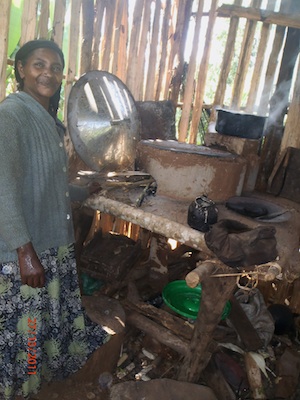Photo Gallery
 Kafa is the birthplace of wild coffee, Coffea arabica, where it has been consumed for more than 1,000 χρόνια. There are now close to 5,000 wild varieties of coffee in this biodiversity hotspot. A unique coffee culture is deeply ingrained in the Ethiopian economy and history. This culture is a key element of the participatory forest management scheme created in the Kafa Biosphere Reserve to avoid deforestation and boost economic development.
Kafa is the birthplace of wild coffee, Coffea arabica, where it has been consumed for more than 1,000 χρόνια. There are now close to 5,000 wild varieties of coffee in this biodiversity hotspot. A unique coffee culture is deeply ingrained in the Ethiopian economy and history. This culture is a key element of the participatory forest management scheme created in the Kafa Biosphere Reserve to avoid deforestation and boost economic development.
NABU (The German Nature and Biodiversity Conservation Union) and its partners have worked towards the preservation of these forests obtaining the establishment of the UNESCO Kafa Biosphere Reserve in June 2010 and implementing the project: “Climate Protection and Preservation of Primary Forests – A Management Model using the Wild Coffee Forests in Ethiopia as an Example“.
Το έργο επιτυγχάνεται η παραγωγή και διανομή 11200 εξοικονόμησης ενέργειας σόμπες στους κατοίκους αν και συλλογική προσπάθεια με το Υπουργείο Ενέργειας. 70 άνεργους νέους έχουν εκπαιδευτεί οργανωμένα και εξοπλισμένα και έχουν αναπτυχθεί σε 11 παραγωγή και 25 δορυφορικές θέσεις.
The dependency on biomass energy: a driving force for deforestation
Only 40 χρόνια, μερικοί 40% of the Ethiopian land surface was occupied by forests. Σήμερα, less than 3% remains, largely in the Kafa coffee biosphere reserve, which still boasts large areas of mountainous afromontane cloud forest. The forest ecosystem makes an important contribution to the livelihoods of people in the area. It provides wild coffee, valuable spices and honey from wild bees. It also contains some 25 million tons carbon in above-ground biomass. Μερικοί 600,000 tons of carbon could be removed from the atmosphere annually through natural forest growth – if the forest remains intact. But it is endangered due to clear-cutting for smallholder agriculture and industrial coffee and tea plantations, and the intensive use of biomass.
Αιθιοπία εξυπηρετεί αυτήν την περίοδο για 96 τοις εκατό των ενεργειακών αναγκών της με βιομάζα. Λόγω αυτού του γεγονότος πολλά νοικοκυριά ικανοποιήσει το αίτημά τους με την κοπή δέντρων με βάση τα διαθέσιμα φυσικά δάση / δασικές εκτάσεις και θάμνων εδάφη. Η κατάσταση αυτή έχει αναφερθεί ως μία από τις κινητήριες δυνάμεις για την αποψίλωση των δασών. Παρόμοια με άλλα τμήματα του λαού της χώρας Kafa χρησιμοποιούν κυρίως προϊόντα ξύλου για την πυρκαγιά. Η καυσόξυλα προέρχεται από τα κοντινά δάση. Στην κορυφή του ότι, το καύσιμο βιομάζα χρησιμοποιείται κυρίως αναποτελεσματικά. Αυτό έχει άμεση σχέση με το εισόδημα των νοικοκυριών και τον προϋπολογισμό του χρόνου. Το πιο αναποτελεσματικά το ξύλο χρησιμοποιείται η περισσότερες γυναίκες το χρόνο και τα παιδιά θα δαπανήσουν για συλλογή καυσόξυλων.
There is no electric power plant in the Biosphere Reserve. Electricity is supplied only to a few areas of the reserve by an external hydro-power plant.
Energy-efficient stoves and other renewable energy sources
Among the activities carried out by NABU’s Climate and Forest Project to mitigate the impact of meeting energy requirement using biomass, there are two main lines of action: promotion of community plantations with fast-growing tree species as fuel wood and introduction of efficient wood-burning stoves.
In this last case, the target of the project is to introduce energy-saving stoves to the communities in Kafa Biosphere Reserve. 11200 stoves were distributed until September 2012. The plan says that 10000 stoves will be distributed to households with high wood consumption by September 2012. Η νέα τεχνική αυτών των θερμαστρών, όχι μόνο μειώνει την ποσότητα του ξύλου που απαιτείται για το μαγείρεμα κατά το ήμισυ, αλλά επίσης εξοικονομεί τα δάση, χρόνος για τον χρήστη και παράγει λιγότερο καπνό και φωτιά. The stoves are therefore a source of great relief to the people and the forest and have been very well received.
Να παράγει και να διανέμει τις σόμπες NABU συνεργάζεται στενά με την Kafa Ζώνη Διεύθυνση υδάτων, Ορυχείων και Ενέργειας. Στο πλαίσιο αυτής της συνεργασίας 70 νέοι άνεργοι είχαν εκπαιδευτεί ως παραγωγοί κουζίνα και υποστηρίζονται για να αρχίσει τις δραστηριότητές της παραγωγής τους.
In collaboration with GLEN (Global Education Network of Young Europeans) a study has been conducted on alternative energy sources where coffee husk briquets, βιο-αερίου και της ηλιακής εμφανίστηκε ως εξίσου σημαντικές.
Annually, in the area of biosphere reserve, περίπου 100 t of coffee husk is produced. This represents an ideal material for briquetting. But not only the coffee husk: dry leftovers from other crops processing (e.g. maize, sorghum etc.) can be used as well. Another source is biogas production, based on two big potential sources: cattle dung and coffee pulp.
The Kafa Water, Mining and Energy Department has started to implement some renewable energy programs in its “5 years strategic plan” – starting from 2011. 450 PV solar panels were distributed until September 2012.
Lessons learned and potential replicability
The acceptance of wood-saving stoves is very high and they are easily adapted by users. Within this context, local communication and education are essential. The importance of the training programme for young people to help them expand their own knowledge of climate and forest protection is recognised. In turn, they can share this knowledge and raise the awareness of other members of their communities.
With regard to energy, solar power has a high potential and there are multiple benefits of using solar energy in the area. But before installing new panels it is necessary to prepare and train technical staff that will work in the zone.
The successful results of this project may have a significant impact on other areas of the region with similar characteristics and needs. This would be the case of Yayu Biosphere Reserve, also in Ethiopia, and of other similar areas, like the Ituri region in the Democratic Republic of Congo.

















